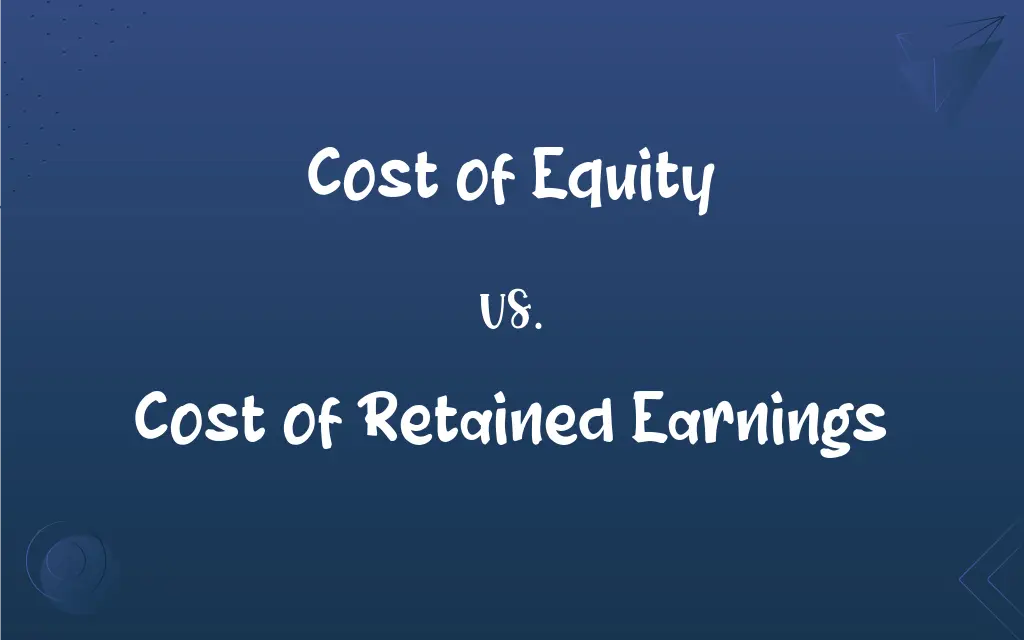Cost of Equity vs. Cost of Retained Earnings: What's the Difference?
By Aimie Carlson & Harlon Moss || Published on December 11, 2023
Cost of equity is the return expected by shareholders for investing in a company, while cost of retained earnings is the opportunity cost of reinvesting profits back into the business.

Key Differences
The cost of equity refers to the return that investors expect for investing in a company's equity, which typically includes dividends and capital gains. The cost of retained earnings, however, is the opportunity cost associated with reinvesting profits back into the company rather than distributing them to shareholders.
Cost of equity is often calculated using models like the Capital Asset Pricing Model (CAPM), reflecting the risk of investing in the company's stock. In contrast, the cost of retained earnings is usually based on the company’s internal estimates of return on reinvested earnings, considering the next best investment alternative.
The cost of equity is visible to external investors and is a crucial factor in their investment decisions. The cost of retained earnings, on the other hand, is an internal metric, important for a company's strategic decision-making about funding projects.
Cost of equity can be influenced by market conditions, company performance, and investor perception. The cost of retained earnings is influenced by the company's investment opportunities and the expected rate of return on these investments.
Raising capital through equity can increase a company's cost of equity due to higher expectations of return from investors. Utilizing retained earnings for investment can be seen as a cost-effective option but comes with the trade-off of not distributing profits as dividends.
ADVERTISEMENT
Comparison Chart
Definition
Expected return by shareholders on equity
Opportunity cost of reinvesting profits
Calculation Method
Often uses CAPM or similar models
Based on internal estimates and alternatives
Visibility
External, important for investors
Internal, important for corporate strategy
Influencing Factors
Market conditions, company risk
Company’s investment opportunities
Impact on Company Financing
Affects equity financing cost
Affects reinvestment and dividend policies
ADVERTISEMENT
Cost of Equity and Cost of Retained Earnings Definitions
Cost of Equity
Cost of equity is used to evaluate the attractiveness of investing in a company.
Investors considered the firm's cost of equity before buying its shares.
Cost of Retained Earnings
Cost of retained earnings is the opportunity cost of reinvesting profits instead of paying dividends.
The company’s cost of retained earnings reflected the forgone dividend payments.
Cost of Equity
Cost of equity is the return that shareholders expect on their investment in a company.
The company's high cost of equity was due to its volatile stock performance.
Cost of Retained Earnings
Cost of retained earnings is an internal measure of reinvestment efficiency.
The company’s low cost of retained earnings indicated efficient use of its profits.
Cost of Equity
Cost of equity reflects the risk of investing in a company’s stock.
The technology firm's innovative but risky projects led to a higher cost of equity.
Cost of Retained Earnings
Cost of retained earnings helps in deciding between reinvestment and dividend distribution.
The board considered the cost of retained earnings in their dividend policy decision.
Cost of Equity
Cost of equity includes expected dividends and capital gains.
The company's consistent dividend payments contributed to a stable cost of equity.
Cost of Retained Earnings
Cost of retained earnings takes into account alternative investment opportunities.
The company’s alternative investment options influenced its cost of retained earnings.
Cost of Equity
Cost of equity can change with investor perception and market conditions.
Economic uncertainty increased the company’s cost of equity.
Cost of Retained Earnings
Cost of retained earnings represents the expected rate of return on reinvested profits.
The firm evaluated the cost of retained earnings for its new project investment.
FAQs
How is the cost of retained earnings determined?
The cost of retained earnings is determined by the opportunity cost of reinvesting earnings rather than distributing them.
What is the cost of equity?
The cost of equity is the return expected by investors for investing in a company's equity.
What factors affect the cost of equity?
Factors like market risk, company performance, and investor expectations affect the cost of equity.
Is the cost of retained earnings always lower than the cost of equity?
Not necessarily, it depends on the company’s investment opportunities and market conditions.
Can companies control their cost of equity?
Companies can influence their cost of equity through strategic decisions and communication with investors.
How does dividend policy relate to the cost of retained earnings?
Dividend policy is directly related, as retained earnings could alternatively be used for dividends.
Does the cost of equity change?
Yes, the cost of equity can change based on market conditions and company performance.
How does the cost of retained earnings impact shareholders?
It impacts shareholders by potentially affecting dividend payments and the value of their investment.
Can the cost of retained earnings be negative?
Theoretically, it can't be negative, as it represents an opportunity cost.
Is the cost of retained earnings the same for all companies?
No, it varies based on each company's specific circumstances and investment opportunities.
Does a high cost of equity indicate a risky investment?
Generally, a higher cost of equity indicates higher perceived risk and expected returns.
Why is the cost of retained earnings important?
It's important for internal decision-making, particularly in reinvestment versus dividend distribution.
Are new projects affected by the cost of equity?
Yes, new projects need to provide a return higher than the cost of equity to be considered worthwhile.
How do investors use the cost of equity?
Investors use it to assess the expected return and risk of investing in a company's stock.
What impact does reinvesting profits have on a company’s growth?
Reinvesting profits can lead to growth if the return on reinvested earnings exceeds the cost of retained earnings.
How does a company's debt level affect its cost of equity?
Higher debt levels can increase the cost of equity due to increased financial risk.
Should companies always reinvest profits?
Not necessarily; it depends on whether reinvested earnings can earn a return above the cost of retained earnings.
How does economic stability affect the cost of equity?
Economic stability can lower the cost of equity by reducing risk and investor return expectations.
Is it better to have a low cost of retained earnings?
A low cost of retained earnings can indicate efficient use of reinvested profits.
Can a company have both a high cost of equity and high cost of retained earnings?
Yes, this can occur if the company is perceived as risky and has limited profitable reinvestment opportunities.
About Author
Written by
Aimie CarlsonAimie Carlson, holding a master's degree in English literature, is a fervent English language enthusiast. She lends her writing talents to Difference Wiki, a prominent website that specializes in comparisons, offering readers insightful analyses that both captivate and inform.
Co-written by
Harlon MossHarlon is a seasoned quality moderator and accomplished content writer for Difference Wiki. An alumnus of the prestigious University of California, he earned his degree in Computer Science. Leveraging his academic background, Harlon brings a meticulous and informed perspective to his work, ensuring content accuracy and excellence.








































































